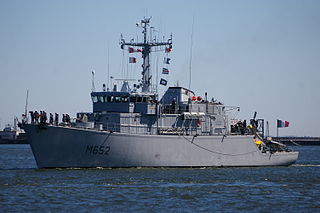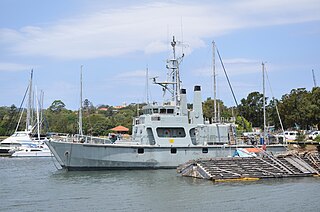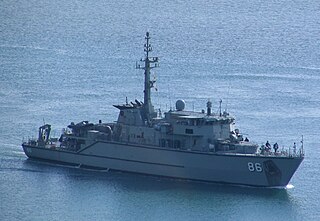
The Armidale class is a class of patrol boats built for the Royal Australian Navy (RAN). Planning for a class of vessels to replace the fifteen Fremantle-class patrol boats began in 1993 as a joint project with the Royal Malaysian Navy, but was cancelled when Malaysia pulled out of the process. The project was reopened in 1999 under the designation SEA 1444, with the RAN as the sole participant. Of the seven proposals tendered, the Austal/Defence Maritime Services (DMS) proposal for twelve vessels based on an enlarged Bay-class patrol boat was selected. Two additional boats were ordered in 2005 to provide a dedicated patrol force for the North West Shelf Venture.
The Royal Australian Navy, although a significant force in the Asia-Pacific region, is nonetheless classed as a medium-sized navy. Its fleet is based around two main types of surface combatant, with limited global deployment and air power capability. However, in 2009, a white paper, Defending Australia in the Asia Pacific Century: Force 2030, was produced by the Australian government which set out a programme of defence spending that will see significant improvements to the RAN's fleet and capabilities.

HMAS Huon, named for the Huon River, is the lead ship of the Huon class of minehunters operated by the Royal Australian Navy (RAN). The first of six ships built by a joint partnership of Australian Defence Industries (ADI) and Intermarine SpA, Huon's hull was fabricated at Intermarine's Italian shipyard, then freighted to ADI facilities at Newcastle for completion. She entered service in 1999.

Fleet Base East is a Royal Australian Navy (RAN) major fleet base that comprises several naval establishments and facilities clustered around Sydney Harbour, centred on HMAS Kuttabul. Fleet Base East extends beyond the borders of Kuttabul and includes the commercially-operated dockyard at Garden Island, and adjacent wharf facilities at nearby Woolloomooloo, east of the Sydney central business district in New South Wales, Australia. Fleet Base East is one of two major facilities of the RAN, the other facility being Fleet Base West. The fleet operates in the Pacific Ocean.

HMAS Waterhen is a Royal Australian Navy (RAN) base located in Waverton on Sydney's lower north shore, within Sydney Harbour, in New South Wales, Australia. Constructed on the site of a quarry used to expand Garden Island in the 1930s, the location was used during World War II as a boom net maintenance and storage area. In 1962, the area was commissioned as a base of the RAN, and became home to the RAN's mine warfare forces. Waterhen was the first small-ship base established by the RAN, and from 1969 to 1979 was also responsible for the RAN's patrol boat forces.

The Osprey class are a series of coastal minehunters designed to find, classify, and destroy moored and bottom naval mines from vital waterways.

MSA Brolga (1102) was a minesweeper operated by the Royal Australian Navy (RAN) between 1988 and 2003. Launched in 1975 by Australian Shipbuilding Industries, the ship was designed for the Department of Transport as the lighthouse tender Lumen. Originally operating as a supply vessel for lighthouses around northern Queensland and the Torres Strait, the transition in lighthouse lights from acetylene gas to solar power meant there was less demand for the vessel, and by 1988, the Department of Transport was looking to sell the ship.

The Tripartite class is a class of minehunters developed from an agreement between the navies of Belgium, France and the Netherlands. A total of 35 ships were constructed for the three navies. The class was constructed in the 1980s–1990s in all three countries, using a mix of minehunting, electrical and propulsion systems from the three member nations. In France, where they are known as the Éridan class they are primarily used as minehunters, but have been used for minesweeping and ammunition transport in Belgium and the Netherlands, where the Tripartites are known as the Alkmaar class.

The Bay-class Minehunter Inshores were a class of catamaran-hull mine warfare vessels operating with the Royal Australian Navy from 1986. Also referred to as the MHCAT, the class was an attempt to produce a locally designed inshore mine warfare vessel. Two prototype ships were ordered in 1981, with the first ship, Rushcutter, commissioned in November 1986. The two ships experienced delays in construction, and the RAN resorted to acquiring six minesweeper auxiliaries (MSA) under the Craft of Opportunity Program to provide an interim mine-warfare capability, while also keeping Ton-class minesweeper HMAS Curlew in service until 1990, well beyond her intended decommissioning date. The ships did not enter service until 1993, due to problems with the sonar.

HMAS Diamantina, named after the Diamantina River, is a Huon-class minehunter currently serving in the Royal Australian Navy (RAN). Built by a joint partnership between Australian Defence Industries (ADI) and Intermarine SpA, Diamantina was constructed at ADI's Newcastle shipyard, and entered service in 2000.

HMAS Melville is the second ship of the Leeuwin class of hydrographic survey vessels operated by the Royal Australian Navy (RAN).

HMAS Norman, named for the Norman River in Queensland, is the third Huon-class minehunter to serve in the Royal Australian Navy (RAN). Built by a joint partnership between Australian Defence Industries (ADI) and Intermarine SpA, Norman was constructed at ADI's Newcastle shipyard, and entered service in 2000.

HMAS Gascoyne, named for the Gascoyne River, is the fourth of six Huon-class minehunters constructed for and currently in service with the Royal Australian Navy (RAN). Built by a joint partnership between Australian Defence Industries (ADI) and Intermarine SpA, Gascoyne was constructed at ADI's Newcastle shipyard, and entered service in 2000.

HMAS Hawkesbury, named for the Hawkesbury River, is the second Huon-class minehunter to have been built for the Royal Australian Navy (RAN). Built by a joint partnership between Australian Defence Industries (ADI) and Intermarine SpA, Hawkesbury was constructed at ADI's Newcastle shipyard, and entered service in 2000.

HMAS Yarra is the sixth Huon-class minehunter to have been built for the Royal Australian Navy (RAN) and the fourth warship to be named after the Yarra River in Victoria. Built by a joint partnership between Australian Defence Industries (ADI) and Intermarine SpA, Yarra was constructed at ADI's Newcastle shipyard, and entered service in 2003.

The Paluma-class motor launch was a class of four hydrographic survey motor launches operated by the Royal Australian Navy (RAN). Built in Port Adelaide between 1988 and 1990, the four catamarans were primarily based at HMAS Cairns in Cairns, Queensland, and operated in pairs to survey the waters of northern Australia.

The Lerici class is a class of minehunters constructed by Intermarine SpA and owned and operated by the Italian Navy. The class incorporates two subclasses: the first four ships are referred to specifically as the first series of the Lerici class, while eight more ships produced to a slightly modified design are known as "second series Lericis" or as the Gaeta class.

The Arafura class is a class of offshore patrol vessels being built for the Royal Australian Navy (RAN). Initially proposed in the 2009 Defence White Paper and marked as procurement project SEA 1180, it was originally planned that 20 Offshore Combatant Vessels (OCV) would replace 26 vessels across four separate ship classes: the Armidale-class patrol boats, the Huon-class minehunters, the Leeuwin-class survey vessels, and the Paluma-class survey motor launches. Although having a common design, the ships would use a modular mission payload system to fulfill specific roles; primarily border patrol, mine warfare, and hydrographic survey. The 2013 Defence White Paper committed to the OCV project as a long-term goal, but opted in the short term for an accelerated procurement of an existing design to replace the Armidales, and life-extension refits for the other types. This resulted in the Offshore Patrol Vessel (OPV) project and the number of vessels reduced to 12. However, this was further increased to 14 when 2 further Mine Counter Measures variants were proposed under SEA 1905.

The Craft of Opportunity Program (COOP) was a Royal Australian Navy (RAN) acquisition program intended to supplement the navy's mine warfare capability with civilian vessels that could be quickly converted into minesweepers. Vessels acquired under COOP were not commissioned into the RAN, and instead operated with the prefix "MSA" (Minesweeper Auxiliary).


















